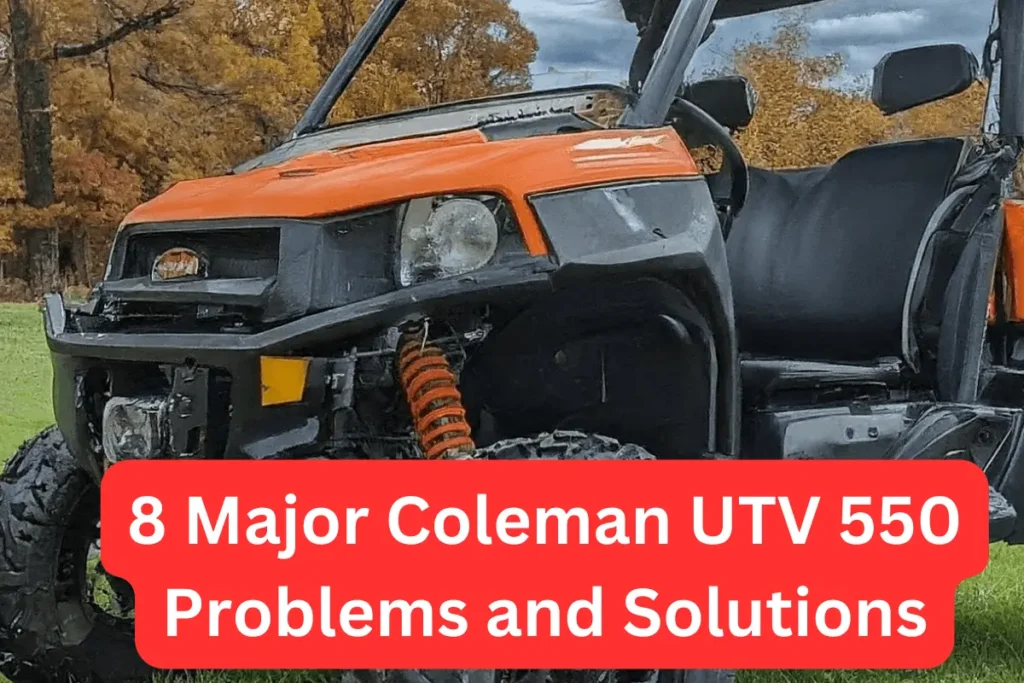Are you facing problems with the Honda Pioneer 1000? You are not alone because most owners also face issues with this.
The most common Honda Pioneer 1000 problems are transmission problems, engine air take, engine light issues, engine stalling issues, excessive cabin heat, scalding steam rising up through the seat, and harsh ride issues.
We discuss these issues in detail with their easy solutions in a way that a non-technical person also solve them by reading our guide.
7 Major Honda Pioneer 1000 Problems
Now we are going to discuss the major problems of the Honda Pioneer 1000 with their easy solutions and these are the same as Honda Pioneer 700 issues.
1. Transmission Problems
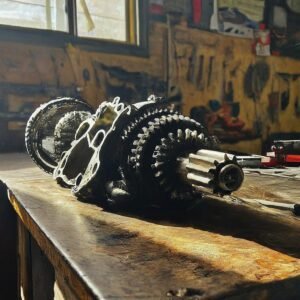
Here are some common transmission problems that Honda Pioneer 1000 owners may face. Continue your journey by exploring the top speed of Honda Pioneer 1000.
1. Shifting Issues
One of the most common transmission problems in the Honda Pioneer 1000 is shifting issues. You may experience difficulty in shifting gears, such as gears not engaging properly or grinding noises when shifting. Various factors, including worn-out clutch plates, a faulty shift fork, or a damaged shift drum can cause this.
To resolve shifting issues, you can start by checking the clutch plates for wear and replacing them if necessary. If the clutch plates are in good condition, you may need to inspect the shift fork and shift drum for any damage or misalignment. If you are not comfortable performing these inspections and repairs yourself, it is recommended to take your Honda Pioneer 1000 to a certified mechanic.
2. Transmission Slipping
Another common transmission problem is transmission slipping. You may notice that your Honda Pioneer 1000’s transmission slips out of gear or experiences a loss of power while driving. This can be caused by a worn-out clutch, low transmission fluid level, or a faulty shift solenoid.
To address transmission slipping, you can start by checking the transmission fluid level and topping it up if it is low. If the fluid level is fine, you may need to inspect the clutch for wear and replace it if necessary.
Additionally, a faulty shift solenoid can also cause transmission to slip, and it may need to be replaced by a professional mechanic.
3. Overheating
Overheating is another transmission problem that some Honda Pioneer 1000 owners may encounter. Continuous heavy use or towing heavy loads can cause the transmission to overheat, leading to poor performance and potential damage to the transmission components.
To prevent transmission overheating, it is essential to ensure that your Honda Pioneer 1000 is adequately cooled. Regularly check the cooling system for any leaks or blockages and clean the radiator fins to maintain proper airflow.
Additionally, avoid excessive towing or pushing the vehicle beyond its recommended limits to prevent overheating.
Some Other Transmission Issues
- Transmission Fluid Leaks: Transmission fluid leaks can lead to low fluid levels, which can cause overheating and premature wear of transmission components. Inspect the transmission and surrounding areas for any signs of fluid leaks, such as puddles or stains on the ground or transmission housing. If you identify a leak, locate and repair the source of the leak, whether it’s a damaged seal, gasket, or transmission line. Be sure to replenish the transmission fluid to the appropriate level after addressing the leak.
- Strange Noises or Vibrations: Unusual noises or vibrations coming from the transmission, such as whining, humming, or rattling sounds, can indicate various issues, including worn bearings, damaged gears, or improper gear engagement. Perform a visual and auditory inspection of the transmission while the vehicle is running to identify any abnormal sounds or vibrations. If necessary, consult a professional mechanic for a thorough diagnosis and repair of the underlying cause.
- Delayed Engagement or Sluggish Response: Delayed engagement or a sluggish response when accelerating or shifting gears can be caused by several factors, including low transmission fluid levels, a worn clutch, or internal transmission damage. Check the transmission fluid level and quality, and refill or replace it as needed. Additionally, inspect the clutch system for wear and adjust or replace any worn components. If the issue persists, have the transmission inspected by a qualified mechanic for further diagnosis and repair.
2. Engine air intake
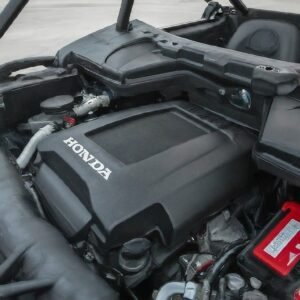
Here a some common engine air intake problems that Honda Pioneer 1000 owners may encounter. Also explore the issues of Pioneer 520.
1. Clogged Air Filter
A clogged air filter is one of the most common air intake problems in any vehicle, including the Honda Pioneer 1000. Over time, dirt, dust, and debris can accumulate in the air filter, restricting the airflow to the engine. This might make the engine work less effectively, use up more fuel, and could even harm the engine.
The solution to this problem is relatively simple. Regularly inspect the air filters, if they are dirty clean them, and if needed replace them. Cleaning or replacing the air filter will make sure that the engine receives a sufficient amount of clean air for optimal performance.
2. Water in the Air Intake
Another common problem with the Honda Pioneer 1000 engine air intake is water infiltration. If you frequently ride through water or encounter heavy rain, there is a possibility that water may enter the air intake system. This can cause engine misfires, rough idling, and even hydrolock, which can result in severe engine damage.
To prevent water from entering the air intake, it is essential to install an air intake snorkel kit. An air intake snorkel kit raises the air intake above the water level, allowing the vehicle to safely traverse through water without the risk of water entering the engine. Additionally, it is crucial to avoid driving through deep water or flooded areas whenever possible.
3. Dust and Debris in the Air Intake
Off-roading often involves driving through dusty and dirty terrains, which can lead to the accumulation of dust and debris in the air intake system. This can result in reduced engine performance and increased wear and tear on engine components.
To prevent dust and debris from entering the air intake, it is recommended to install a pre-filter or a dust cover. A pre-filter is an additional layer of protection that traps larger particles before they reach the air filter. This helps prolong the life of the air filter and ensures that the engine receives clean air.
Some other issues
- Air Filter Housing Damage: The air filter housing protects the air filter from debris and contaminants. If the housing is damaged or improperly sealed, it can allow dirt and debris to enter the engine, causing damage and affecting performance. Inspect the air filter housing for any signs of damage and repair or replace it as necessary.
- Air Intake Hose Leaks: The air intake hose connects the air filter housing to the engine intake manifold. If the hose develops cracks or leaks, it can allow unmetered air to enter the engine, leading to rough idling, stalling, and reduced power. Inspect the air intake hose for any signs of damage and replace it if necessary to restore proper engine operation.
- Faulty Mass Airflow Sensor (MAF): The MAF sensor measures the amount of air entering the engine and sends this information to the engine control unit (ECU) to adjust fuel delivery accordingly. A faulty MAF sensor can result in an incorrect air/fuel mixture, leading to engine hesitation, poor acceleration, and increased fuel consumption. If you suspect a faulty MAF sensor, have it tested and replaced if necessary by a qualified technician.
- Restricted Air Intake: Sometimes, the air intake itself can become blocked or restricted, preventing sufficient airflow to the engine. Check for any obstructions or debris in the air intake ducts and remove them to restore proper airflow.
- Dirty Throttle Body: The throttle body manages how much air goes into the engine. If it becomes dirty or clogged with carbon deposits, it can affect airflow and engine performance. Clean the throttle body periodically using throttle body cleaner to remove any buildup and restore proper operation.
Also explore that How to Check & Change Oil on Honda Pioneer 1000.
3. Engine light Issues
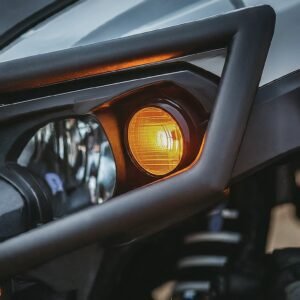
Here are some Honda Pioneer 1000 engine light issues that its owner faces.
1. Loose Gas Cap
One of the simplest and most common reasons for the engine light to come on is a loose gas cap. If the gas cap is not tightened properly, it can cause the fuel system to lose pressure, triggering the engine light. To fix this issue, simply tighten the gas cap until you hear a clicking sound. After a few driving cycles, the engine light should turn off on its own.
2. Faulty Oxygen Sensor
Another potential cause of the engine light problem is a faulty oxygen sensor. The oxygen sensor is responsible for monitoring the amount of oxygen in the exhaust gases, which helps the engine adjust its fuel-to-air ratio. If the sensor is not functioning properly, it can lead to poor fuel economy and increased emissions. In this case, it is recommended to have the oxygen sensor replaced by a qualified mechanic.
3. Malfunctioning Mass Airflow Sensor
The mass airflow sensor checks how much air goes into the engine and helps decide the right amount of fuel to inject. If this sensor malfunctions, it can cause the engine light to come on. Symptoms of a faulty mass airflow sensor include rough idling, decreased fuel efficiency, and loss of power. Consult with a professional mechanic to diagnose and replace the sensor if necessary.
4. Loose or Damaged Spark Plugs
Spark plugs are essential components of the engine’s ignition system. If they become loose or damaged, it can result in misfires, reduced engine performance, and eventually trigger the engine light. Regularly inspect the spark plugs and ensure they are tightened to the manufacturer’s specifications. If any damage is detected, it is advisable to replace them with new ones.
5. Issues with the Catalytic Converter
The catalytic converter is responsible for reducing harmful emissions by converting them into less harmful substances. If it becomes clogged or damaged, it can cause the engine light to illuminate. In addition to the engine light, symptoms of a faulty catalytic converter may include decreased engine performance and increased fuel consumption. It is recommended to have a professional inspect and replace the catalytic converter if necessary.
Some other issues
- Ignition System Problems: Issues with the ignition system, such as faulty spark plugs or ignition coils, can also trigger the engine light to come on. The ignition system is responsible for igniting the air-fuel mixture in the combustion chamber. If any components are worn or damaged, it can lead to misfires, rough idling, and decreased fuel efficiency. Regular maintenance and inspection of the ignition system can help prevent these issues.
- Vacuum Leak: A vacuum leak occurs when there’s an unintended gap or hole in the vacuum system, causing air to enter the engine without being properly measured. This can lead to a lean air-fuel mixture, resulting in rough idling, stalling, and decreased engine performance. Inspect the vacuum hoses and connections for any signs of damage or wear, and replace them if necessary to prevent vacuum leaks.
- Transmission Problems: Issues with the transmission, such as low fluid levels or worn-out components, can also trigger the engine light to illuminate. The transmission is responsible for transferring power from the engine to the wheels, and any malfunctions can lead to rough shifting, slipping, or hesitation. Regular maintenance and fluid checks can help prevent transmission problems and ensure smooth operation.
4. Engine Stalling Issues

It is the most common issue of Pioneer 1000 that its owner faces. Here are a few problems of engine stalling. Also explore the issues of Honda Pioneer 500.
1. Fuel System Issues
One of the main culprits behind engine stalling is fuel system problems. If your Honda Pioneer 1000 is not getting enough fuel or if the fuel is contaminated, it can result in engine stalling. Here are some things you can do to fix this problem:
- Check the fuel filter: A clogged fuel filter can restrict fuel flow to the engine. Check the fuel filter and change it if needed.
- Inspect the fuel lines: Look for any signs of damage or leaks in the fuel lines. If you find any issues, repair or replace the fuel lines.
- Drain and refill the fuel: If you suspect that the fuel is contaminated, drain the fuel tank and refill it with fresh, clean fuel.
2. Ignition System Problems
The ignition system is really important for the engine to work correctly. If there are issues with the ignition system, it can lead to engine stalling. Here are some solutions to address ignition system problems:
- Check the spark plugs: Fouled or worn-out spark plugs can cause engine misfires and stalling. Check the spark plugs and put in new ones if needed.
- Inspect the ignition coils: Faulty ignition coils can disrupt the spark and result in engine stalling. Test the ignition coils and replace them if needed.
- Verify the spark plug wires: Damaged or loose spark plug wires can cause weak or no spark, leading to engine stalling. Make sure the spark plug wires are in good shape and connected correctly.
3. Air Intake Issues
Air intake problems can also contribute to engine stalling in the Honda Pioneer 1000. If the engine is not getting enough air or if the air intake system is clogged, it can affect the engine’s performance. Here are some steps to address air intake issues:
- Clean or replace the air filter: A dirty or clogged air filter can restrict airflow to the engine, resulting in stalling. Keep the air filter clean or change it often to make sure the engine gets enough air.
- Inspect the air intake system: See if anything is blocking it or if there’s any damage. Remove any debris or repair any damage to allow for smooth airflow.
- Check the throttle body: A malfunctioning throttle body can disrupt the air-fuel mixture, leading to engine stalling. Inspect the throttle body and clean it if necessary.
Other Issues
- Electrical Problems: Electrical issues, such as a weak battery, corroded battery terminals, or faulty wiring, can disrupt the engine’s electrical system and lead to stalling. Make sure a strong and clean electrical connection throughout the vehicle can help prevent engine stalling.
- Overheating: Engine overheating can cause various problems, including engine stalling. Check the coolant levels and ensure proper cooling system function to prevent overheating-related issues.
- Transmission Problems: Issues with the transmission, such as low transmission fluid levels or a worn clutch, can also cause engine stalling. Regular maintenance and inspection of the transmission system can help prevent these problems.
- Throttle Body Issues: A dirty or malfunctioning throttle body can disrupt the engine’s air-fuel mixture and cause stalling. Cleaning or replacing the throttle body as needed can help restore proper engine function.
- Exhaust System Blockages: Blockages in the exhaust system, such as a clogged catalytic converter or a damaged muffler, can restrict exhaust flow and lead to engine stalling. Inspecting and clearing any obstructions in the exhaust system can help prevent this issue.
5. Excessive cabin heat

Several factors can contribute to excessive cabin heat in the Honda Pioneer 1000. Understanding these causes can help you identify the source of the problem and find an appropriate solution.
1. Engine Heat
One of the primary sources of cabin heat is the engine itself. The Honda Pioneer 1000 has a powerful engine that generates a significant amount of heat during operation. This heat can radiate into the cabin, especially if there are any gaps or openings in the engine compartment.
2. Insufficient Insulation
Another common cause of excessive cabin heat is insufficient insulation. If the vehicle’s cabin is not properly insulated, heat from the engine, exhaust, or external environment can easily penetrate the cabin, making it uncomfortable for the occupants.
3. Inadequate Ventilation
Poor ventilation can also contribute to excessive cabin heat. If the vehicle’s ventilation system is not functioning optimally or if there are any obstructions in the air vents, the hot air inside the cabin may not be effectively circulated or expelled, leading to a buildup of heat.
Solutions to Excessive Cabin Heat
Now that we have identified some common causes of excessive cabin heat in the Honda Pioneer 1000, let’s explore some potential solutions to help you overcome this issue and enjoy a cooler ride.
Engine Compartment Insulation
One effective solution is to insulate the engine compartment to minimize the transfer of heat into the cabin. Adding heat shields or insulation materials around the engine and exhaust system can help reduce the amount of heat radiating into the cabin, resulting in a cooler and more comfortable ride.
Cabin Insulation
Improving the insulation within the cabin itself can also help in reducing excessive heat. Consider adding insulation materials to the walls, floor, and ceiling of the cabin to create a barrier against external heat sources. This can significantly improve the overall comfort level inside the vehicle.
Enhance Ventilation
Improving the ventilation system can help expel hot air and bring in fresh air from the outside. Ensure that the air vents are not blocked and are functioning properly. Additionally, installing additional fans or vents can enhance the airflow within the cabin, promoting better heat dissipation.
Use Heat-Reflective Window Tint
Applying a heat-reflective window tint to the windows of your Honda Pioneer 1000 can help reduce the amount of heat entering the cabin through the glass. This tint can block a significant portion of the sun’s heat, keeping the interior cooler and more comfortable.
6. Scalding steam Rising up through the seat
If you own a Honda Pioneer 1000, you may have experienced the unsettling problem of scalding steam rising up through the seat. This issue can be both uncomfortable and potentially dangerous, so it’s important to address it promptly.
Several factors can contribute to scalding steam rising up through the seat of your Honda Pioneer 1000.
1. Faulty Radiator Cap
A faulty radiator cap can cause excessive pressure to build up in the cooling system, leading to steam escaping through the seat. If the cap is not sealing properly or is damaged, it may need to be replaced.
2. Coolant Leak
A coolant leak can result in low coolant levels, which can cause the engine to overheat. When the engine overheats, steam can escape through various openings, including the seat. Inspect your vehicle for any signs of coolant leaks and repair them as soon as possible.
3. Blocked Radiator or Cooling System
If the radiator or cooling system is blocked or clogged, it can restrict the flow of coolant and cause the engine to overheat. This can result in steam escaping through the seat. Regular maintenance and cleaning of the radiator and cooling system can help prevent this issue.
Solutions to Fix the Scalding Steam Issue
Now that we’ve identified some possible causes, let’s explore the solutions to fix the scalding steam issue in your Honda Pioneer 1000:
- Replace the Radiator Cap: If you suspect that a faulty radiator cap is the culprit, it’s recommended to replace it with a new one. Make sure to choose a cap that is compatible with your vehicle’s cooling system and follow the manufacturer’s instructions for installation.
- Repair Coolant Leaks: If you find any coolant leaks, it’s crucial to repair them promptly. Depending on the severity of the leak, you may be able to fix it yourself or seek assistance from a professional mechanic. Remember to use the recommended coolant for your Honda Pioneer 1000.
- Clean the Radiator and Cooling System: Regularly cleaning the radiator and cooling system can help prevent blockages and ensure optimal performance. Follow the manufacturer’s guidelines on how to properly clean these components or consult a professional if you’re unsure.
7. Harsh ride Issues
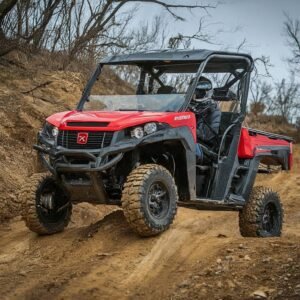
Here are some issues of the harsh ride with your UTV.
Suspension System
The suspension system of the Honda Pioneer 1000 plays a crucial role in providing a smooth and comfortable ride. If you are experiencing a harsh ride, it is possible that there may be an issue with your suspension system. Some common problems include worn-out shocks, damaged springs, or misaligned suspension components.
Solution: The first step in resolving suspension-related issues is to inspect the system thoroughly. Check for any signs of damage or wear on the shocks, springs, and other suspension components. If you notice any issues, it is recommended to replace the damaged parts with genuine Honda replacements. Additionally, consider upgrading to aftermarket suspension components that are specifically designed to improve ride quality.
Tire Pressure
Another factor that can contribute to a harsh ride is incorrect tire pressure. If the tire pressure is too high or too low, it can affect the overall ride quality and make the vehicle feel bumpy and uncomfortable.
Solution: Check the tire pressure regularly and ensure that it is within the manufacturer’s recommended range. You can find the recommended tire pressure in the owner’s manual or on a sticker located on the vehicle. Use a reliable tire pressure gauge to measure the pressure accurately and adjust it as needed. Maintaining the correct tire pressure will not only improve the ride quality but also enhance the overall performance and fuel efficiency of your Honda Pioneer 1000.
Terrain and Driving Conditions
The harshness of the ride can also be influenced by the type of terrain and driving conditions you encounter. Rough or uneven surfaces, such as rocky trails or unpaved roads, can make the ride feel more jarring and uncomfortable.
Solution: While it may not be possible to control the terrain or driving conditions entirely, there are steps you can take to minimize the impact on your ride quality. Consider adjusting your driving style by slowing down and avoiding sudden movements or impacts. Additionally, investing in accessories like skid plates and protective guards can help protect the undercarriage of your vehicle and reduce the impact of rough terrain.
Conclusion
As you see here we discuss the major Honda Pioneer 1000 problems with their easy solutions. Now whenever you encounter any of these issues you can solve them easily by reading our guide.
I hope you again come to this website to learn about the problems of the other model of UTV like Coleman UTV issues and many others.

